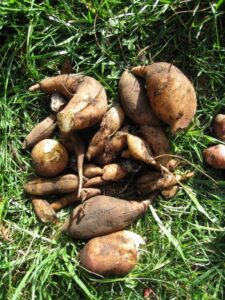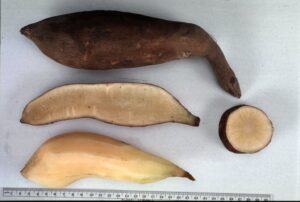
Yacon takes root in Australia
By Clive Larkman
The Columbian Exchange continues to make its impact felt on the world, with the arrival of the yacon on the Australian market. Will this edible tuber make its mark on our nation, or will it prove to be a culinary fad?
between the ‘old world’ of Afro-Eurasia and the ‘new world’ of central and southern America. The effects on the regional communities were huge, so much so, that many culinary ingredients quickly became local staples and are now thought of as part of local history. The world moved on and accepted the changes to local diets. It seems that the exchange has had a fresh burst of energy over the last decade or so. There are so many American plants that have suddenly become popular in modern cuisine, including chillies, chia, and blue tomatoes.
Yacon is another plant that has made its way more recently from the Americas into independent and innovative fruit and vegetable shops here in Australia. There are a variety of common names for yacon around the world. The Spanish term yacón is derived from the Quéchua word ‘yaku’ which means ‘watery’ and is the name most used for this plant across the world1. This tuberous perennial is native to the Andes mountains in northern South America. The scientific name is Smallanthus sonchifolius and it is a member of the Asteraceae, a large family commonly known as the daisy family. It includes Jerusalem artichoke (Helianthus tuberosus), an edible tuber from the northern hemisphere. The flowers, foliage, and even flavour of this artichoke and the yacon are very similar.

Yacon is often mistaken for jicama (Pachyrhizus erosus), another ‘new’ root vegetable from Central America which is starting to become available in the Australian fresh food market. The error comes because they are both light brown, new vegetables from that part of the world But they are botanically quite different. They taste different too and jicama is often seen as an Asian food.
The Andean mountain people have grown yacon for over 700 years, which means it was part diet and medicinal palette of the pre-Incan people. The Incas also used it in their range of crops, and it was part of their selection program for varying climatic tolerances. Yacon grows at a wide range of altitudes and latitudes meaning it is a versatile plant that can tolerate weather patterns from tropical to high mountains. This means it does not need specific cold temperature requirements, or day length ranges, to grow and produce the tubers. However, it will not tolerate extreme cold, i.e., where the ground freezes, which makes it unsuitable for all-year growing in northern Europe and northern USA. It will grow well in most parts of Australia, particularly the east coast, where there is some winter chill. They grow well from Atherton Tablelands to southern Tasmania.

The yacon plant is a tall perennial, except where the ground freezes and is treated as an annual. It grows to two metres high and produces attractive golden yellow flowers in mid to late autumn. Once the flowers finish, the plant will die back over winter, and the tubers can be harvested. It will produce small reddish rhizomes that can be treated like other bulbs and stored for planting in spring when the frosts have finished. It can be grown from seed but may take two seasons to produce the edible tubers. The flowers do not always produce a lot of seed, so it is not viable for home gardeners to rely on their own seed collection.
The large brown tubers of the yacon can be harvested in late autumn and stored like potatoes and onions. They have a thin brown skin that is easily peeled off, or they can be cooked in the ‘jacket’ like spuds. The raw vegetable is a great addition to any salad or similar dish. In many ways, the yacon can be used as you would nice, sweet carrots; in salads, as crudites, baked, steamed, mashed and even juiced. Wherever used, yacon tubers will add some sweetness due to the presence of the fructose called inulin. Inulin is a sweetener that is suitable for diabetics and those wanting a low sugar diet. Yacons are also a very good source of potassium and are low in calories.
Despite having been around for hundreds of years, yacon is a new food for the Australian domestic market. With its sweet flavour, nutritional benefits and adaptability to diverse Australian climates, yacon has every chance to move beyond novelty status and establish itself as a valued addition to both home gardens and commercial produce aisles.
References
- Caetano, B. F. R., de Moura, N. A., Almeida, A. P. S., Dias, M. C., Sivieri, K., & Barbisan, L. F. (2016). Yacon (Smallanthus sonchifolius) as a food supplement: Health-promoting benefits of fructooligosaccharides. Nutrients, 8(7), 436.
